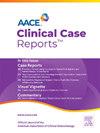血清阴性Graves病或弥散性甲状腺自主性所致轻度甲状腺毒症
IF 1.2
Q3 Medicine
引用次数: 0
摘要
背景/目的弥散性甲状腺自主(DTA)和血清阴性Graves病是甲状腺功能亢进的罕见病因,临床表现相似。本病例报告强调了这些实体之间的诊断挑战。病例表现男性,35岁,表现为心悸、出汗、小甲状腺肿大。TSH为0.249 mIU/L(参考:0.45-4.5 mIU/L),游离T4为3.0 ng/dL(参考:0.88-1.77 ng/dL)。甲状腺过氧化物酶抗体、TRAb、TSI反复阴性。超声显示弥漫性甲状腺肿大,放射性碘摄取35%(参考文献:10% ~ 35%),甲状腺显像显示弥漫性碘摄取增加,提示甲状腺功能亢进,无结节。每日5毫克甲巯咪唑治疗6个月内症状消失。甲状腺活检有助于区分DTA和血清阴性Graves病。DTA表现为结节性增生,无淋巴细胞浸润,提示非自身免疫性,而血清阴性Graves病表现为弥漫性滤泡增生,伴淋巴细胞浸润,与典型Graves病一样,尽管自身抗体检测不到。TRAb结果假阴性的可能性使诊断复杂化,高达22%最初诊断为DTA的患者在重新检测后检测出TRAb阳性。一些DTA病例可能涉及TSH受体基因突变。结论本病例突出了鉴别DTA、血清阴性Graves病和典型Graves病与初始假阴性的复杂性。采用系统的方法进行重复检测,可行时进行活检,对于区分这些实体至关重要。由于这些疾病有不同的缓解率,并由不同的机制驱动,因此需要进一步的组织学分析研究来明确结果并制定量身定制的管理方法。本文章由计算机程序翻译,如有差异,请以英文原文为准。
Mild Thyrotoxicosis due to Seronegative Graves’ Disease or Disseminated Thyroid Autonomy
Background/Objective
Disseminated thyroid autonomy (DTA) and seronegative Graves’ disease are rare causes of hyperthyroidism with similar clinical presentations. This case report highlights the diagnostic challenges between these entities.
Case Presentation
A 35-year-old male presented with palpitations, diaphoresis, and a small goiter. His TSH was 0.249 mIU/L (reference: 0.45–4.5 mIU/L) and free T4 was 3.0 ng/dL (reference: 0.88–1.77 ng/dL). Thyroid peroxidase antibodies, TRAb, and TSI were repeatedly negative. Ultrasound showed a diffusely enlarged thyroid, and radioactive iodine uptake was 35% (reference: 10% to 35%) with thyroid scintigraphy revealing diffusely increased uptake, indicating a hyperfunctioning thyroid without nodules. Treatment with Methimazole 5 mg daily resolved symptoms within 6 months.
Discussion
Thyroid biopsy can help distinguish DTA from seronegative Graves disease. DTA is marked by nodular hyperplasia without lymphocytic infiltration, indicating a non-autoimmune nature, while seronegative Graves’ disease exhibits diffuse follicular hyperplasia with lymphocytic infiltration, just as typical Graves’ disease despite undetectable autoatibodies. The possibility of false-negative TRAb results complicates diagnosis, with up to 22% of patients initially diagnosed with DTA later testing TRAb-positive upon retesting. Some cases of DTA may involve TSH receptor gene mutations.
Conclusion
This case highlights the complexity of distinguishing DTA, seronegative Graves’ disease and typical Graves’ disease with initial false negative testing. A systematic approach with repeat testing and, when feasible, biopsy, is critical to distinguish these entities. Further studies with histologic analysis are needed to clarify outcomes and develop tailored managements, as these conditions have different remission rates and are driven by different mechanisms.
求助全文
通过发布文献求助,成功后即可免费获取论文全文。
去求助
来源期刊

AACE Clinical Case Reports
Medicine-Endocrinology, Diabetes and Metabolism
CiteScore
2.30
自引率
0.00%
发文量
61
审稿时长
55 days
 求助内容:
求助内容: 应助结果提醒方式:
应助结果提醒方式:


